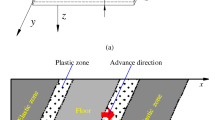Abstract
Numerous sudden surface collapses induced by shallow partial mining in the Datong Jurassic coal seam have caused fatalities, significant property losses and brought about harmful results to the environment. By introducing efficient pillar widths and using the Voronoi diagram, irregular pillar stability can be estimated rationally. Theoretical analysis and numerical simulation demonstrate that the failure of a single pillar increases the load on surrounding pillars. If the magnitude of the transferred load is sufficiently high, the adjoining pillars will also fail in a chain reaction. This can be interpreted by the merger of inner stress arches combined with the external stress arch. In this paper, the evolution mode of sudden surface collapse caused by shallow partial mining is proposed and has been verified by ‘similar material simulation.’ Finally, the potential of sudden surface collapse is determined and an example of collapse prediction and prevention of surface building damage with relocation is given.



















Similar content being viewed by others
References
Be′rest P, Brouard B, Feuga B, Karimi-Jafari M (2008) The 1873 collapse of the Saint-Maximilien panel at the Varangeville salt mine. Int J Rock Mech Min Sci 45:1025–1043
Bell FG, Stacey TR, Genske DD (2000) Mining subsidence and its effect on the environment: some differing examples. Environ Geol 40(1–2):135–152
Bell FG, Donnelly LJ, Genske DD, Ojeda J (2005) Unusual cases of mining subsidence from Great Britain, Germany and Colombia. Environ Geol 47:620–631
Brady BHG, Brown ET (1994) Rock mechanics for underground mining. Kluwer Academic Publishers, London, p 438
Cui XM, Miao XX, Wang J-A (2000) Improved prediction of differential subsidence caused by underground mining. Int J Rock Mech Min Sci 37:615–627
Cui XM, Wang JC, Liu YS (2001) Prediction of progressive surface subsidence above longwall coal mining using a time function. Int J Rock Mech Min Sci 38:1057–1063
Hedley DGF, Grant F (1972) Stope-and-pillar design for the Elliot Lake Uranium Mines. Bull Can Inst Min Metall 65:37–44
Krauland N, Soder PE (1987) Determining pillar strength from pillar failure observations. Eng Min J 8:34–40
Kwinta A, Hejmanowski R, Sroka A (1996) A time function analysis used for the prediction of rock mass subsidence. In: Gui yuguang, Golosinski TS (eds) Mining science and technology. A.A. Balkema: Rotterdam, pp 419–424
Litwiniszyn J (2000) The influence of the rate of mining operations on the development of subsidence troughs. Arch Min Sci 45:323–331
Liu TQ (1981) Surface movement, overburden failures and its application. Coal Industry Press, Beijing (in Chinese)
Lunder PJ, Pakalnis R (1997) Determination of the strength of hard rock pillars. Bull Can Inst Min Metall 90:51–55
Martin CD, Maybee WG (2000) The strength of hard-rock pillar. Int J Rock Mech Min Sci 37:1239–1246
Merad MM, Verdel T, Roy B, Kouniali S (2004) Use of multi-criteria decision-aids for risk zoning and management of large area subjected to mining-induced hazards. Tunn Undergr Space Technol 19:125–138
Murali G, Sheorey PR, Kushwaha A (2001) Numerical estimation of pillar strength in coal mines. Int J Rock Mech Min Sci 38:1185–1192
Okebe A, Boots B, Sugihara K (1992) Concepts and applications of Voronoi diagrams. Wiley, New York
Peng SS (1992) Surface subsidence engineering. SME, New York
Peng XZ, Cui XM, Wang JC (2008) Stability analysis of irregular coal pillars based on Voronoi diagram. J China Coal Soc 33(9):966–970 (in Chinese)
Potvin Y, Hudyma MR, Miller HDS (1989) Design guidelines for open stope support. Bull Can Min Metall 82:53–62
Singh RP, Yadav RN (1995) Prediction of subsidence due to coal mining in Raniganj coalfield, West Bengal, India. Eng Geol 39:103–111
Sjöberg J (1992) Failure modes and pillar behavior in the Zinkgruvan mine. In: Tillerson JA, Wawersik WR (eds) Proceedings of 33rd U.S. rock mechanics symposium, Sante Fe. Rotterdam: A.A. Balkema, pp 491–500
Szwedzicki T (2001) Geotechnical precursors to large-scale ground collapse in mines. Int J Rock Mech Min Sci 38:957–965
Von Kimmelmann MR, Hyde B, Madgwick RJ (1984) The use of computer applications at BCL Limited in planning pillar extraction and design of mining layouts. In: Brown ET, Hudson JA (eds) Proceedings of ISRM symposium: design and performance of underground excavations. British Geotechnical Society, London, pp 53–63
Wang J-A, Zhao ZH, Hou ZY (2007) Study on the catastrophic collapse of surface land induced by mining under a shallow and hard strata. J China Coal Soc 32(10):1051–1056 (in Chinese)
Wang J-A, Shang XC, Ma HT (2008) Investigation of catastrophic ground collapse in Xingtai gypsum mines in China. Int J Rock Mech Min Sci 45:1480–1499
Acknowledgments
This study has been financially supported by the National Basic Research Program of China (973 Program) under Grant No. 2007CB209400, the Program for New Century Excellent Talents in University and the National Natural Science Foundation of China under Grant Nos NECT-07-0798 and 41071328. All those financial supports are gratefully acknowledged.
Author information
Authors and Affiliations
Corresponding author
Rights and permissions
About this article
Cite this article
Cui, X., Gao, Y. & Yuan, D. Sudden surface collapse disasters caused by shallow partial mining in Datong coalfield, China. Nat Hazards 74, 911–929 (2014). https://doi.org/10.1007/s11069-014-1221-5
Received:
Accepted:
Published:
Issue Date:
DOI: https://doi.org/10.1007/s11069-014-1221-5




